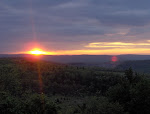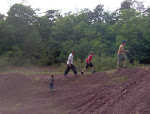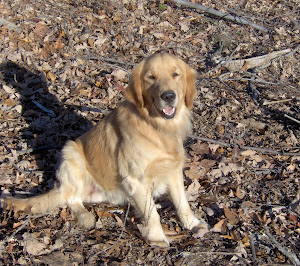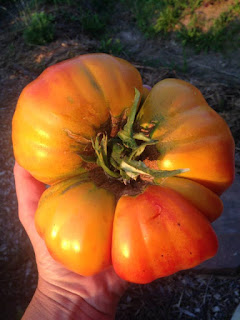By definition permaculture is the development of agricultural ecosystems intended to be sustainable and self sufficient.
As I mentioned in my last post, we took a big leap this year from growing a typical monoculture garden to learning permaculture gardening, A monoculture garden is where you grow the same crop in a row system with pathways separating the rows...a garden like your Grandparents and maybe even your parents grew, The problem with this type of gardening, is the toll it takes, on everything from the soil to the gardeners unrelenting labor! Have you ever heard of the phrase...don't put all your eggs in one basket? Well that is sort of what you are doing in a monoculture garden, If you have pest problems, then a typical garden is just an all you can eat buffet! because the insects that like that particular veggie can just eat their way down the row but, if you adopt permaculture techniques, you are placing your veggie varieties throughout the area and companion planting with other vegetables and herbs which in turn confuses the insects and makes them work harder to find that veggie they like to munch on, all the while making those insects more vulnerable to predators who want to eat them, it becomes a balance of nature!

This is an example of our permacuture gardening. Here we have broccoli, green beans,cucumber, green peppers, jalapeno peppers, brandywine tomatoes, hillbilly tomatoes, marigolds, borage, nasturtiums and calendula planted just in this small space.
Another problem with a typical row style garden is the soil issues. When you plant the same crop in the same area of garden, the soil can then become depleted by that crop using up all the minerals and fertility to grow. some crops are heavy nitrogen feeders and others can add nitrogen to the soil, so by planting a variety of crops you can control a better balance! Row style gardens require tilling which brings beneficial organisms to the surface and ultimately kills them, tilling also brings weed seeds to the surface and allows them to sprout and grow, tilling and leaving the soil exposed allows for erosion and evaporation of water. Permaculture on the other hand alleviates the chore of tilling and ultimately allows the beneficial organisms to thrive and multiply, the soil will not become hard and compacted and weed seeds are suppressed. If you observe your landscape and build up growing mounds in your garden, you can take advantage of stopping and slowing the water runoff by directing it to your garden, after time that water will penetrate into the soil and collect underneath the garden where the plants can access it when needed. by using mulched pathways and hay or straw coverings, more moisture is preserved and weeds are further suppressed.
There is a lot of information about permaculture on the internet and it can become confusing and very hard to wrap your mind around it at first...at least it was for me!
The wonderful thing I discovered about permaculture gardening is that it can be done on any scale and pretty much in any order, this is how we did it!
We took our garden from a traditional row system and created raised growing areas by mounding the soil and creating pathways, we took advantage of our hilly property to lay out the mounds in a way that will stop the flow of water and slow it down enough to capture it in the garden itself. We used mulch in the pathways and planted on the mounds, making sure to keep any exposed soil covered with hay or straw and sometimes grass clippings.
If you look around your area, you may be able to find tree trimming companies who are willing to let you have their unwanted wood chips often for free! We bought straw in large round bails and also found a farmer with 4 year old rotten hay, it was useless to him but, became gold to us! because it was so old and had sat all those years in plastic wrapping, all weed seeds were cooked and killed, by using this in the garden we kept moisture in, weeds suppressed and added organic matter to the soil at the same time! You can use chipped wood and leaves for the same purpose and most of this is free!
Some beds were planted with perennials and some were planted with annuals, on one acre of property we were able to grow an amazing amount of fruits and vegetables.
we have apple. pear, cherry, mulberry, plum, apricot, plucot trees, blueberries, seaberries, honey berries, elder berries and blackberries, we grew celery, cardoon, peas, green beans, noodle beans, pickling cucumbers, marketmore cucumbers, achocha or bolivian cucumber, mexican cucumber, artichoke, broccoli, cauliflower, brussel sprouts, lima beans, onions, lettuce, spinach, kale, collards, carrots, cantaloupe, honey dew melon, watermelon, cabbage, zucchini, yellow squash, butternut squash, patty pan squash, brandywine tomato, hillbilly tomato, roma tomato,pozzano tomato, yellow pear tomato, turnips, radish, strawberry spinach, asparagus, sugar snap peas, swiss chard,green pepper, yellow bell pepper, cayenne pepper, poblano pepper,sweet corn, pumpkins, strawberries, sweet potato, kenebec potato, garlic and walking onions, we also grew just about any herb you can imagine for our zone! This was accomplished on one acre of property which also has a barn and our house!
How well did we produce? We preserved our bounty through canning and dehydrating, plenty of produce for fresh eating, we donated food to a local charity, gave some to friends, family and neighbors and sold a little...Not bad for a small piece of property!
Here is one of many harvests we collected throughout the season!
And this is one of our tomatoes!
I am now convinced, permaculture is the way to grow! This was our first year and it should only get better from here, If you are thinking of gardening in this way, I encourage you to take the leap and give it try, you won't look back!
I will be posting more during our fall garden clean up and what we are doing to put the garden to rest for winter, so please come back and check us out!










































